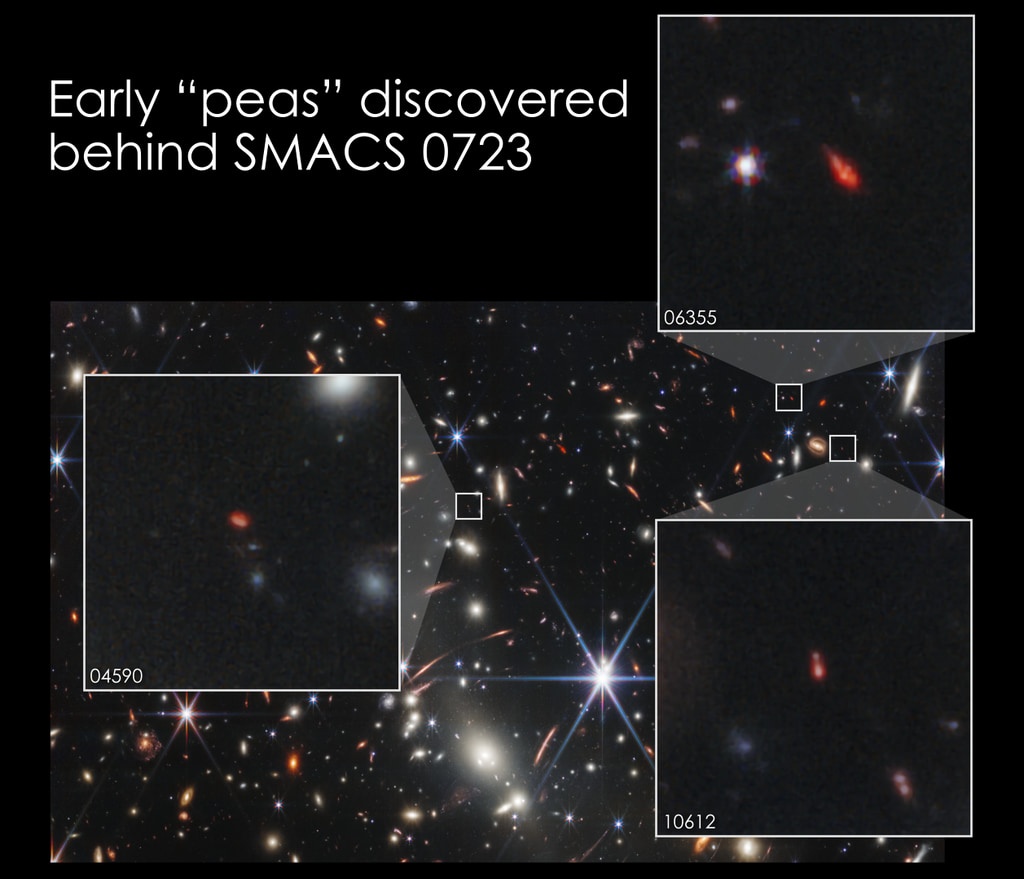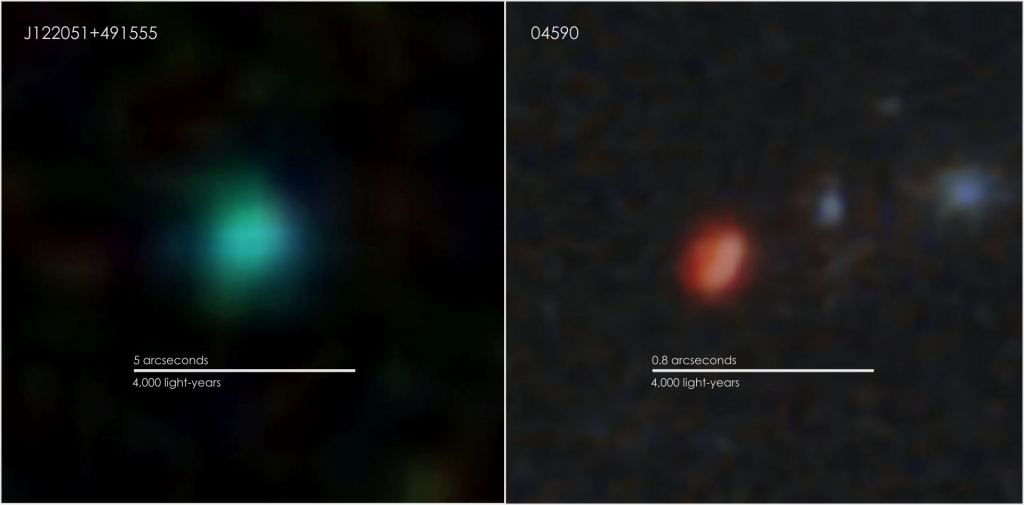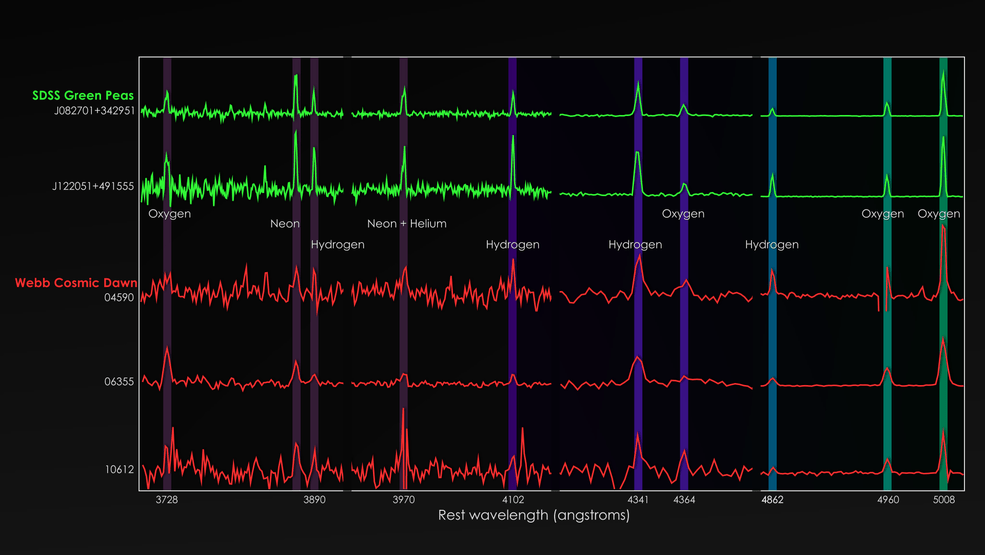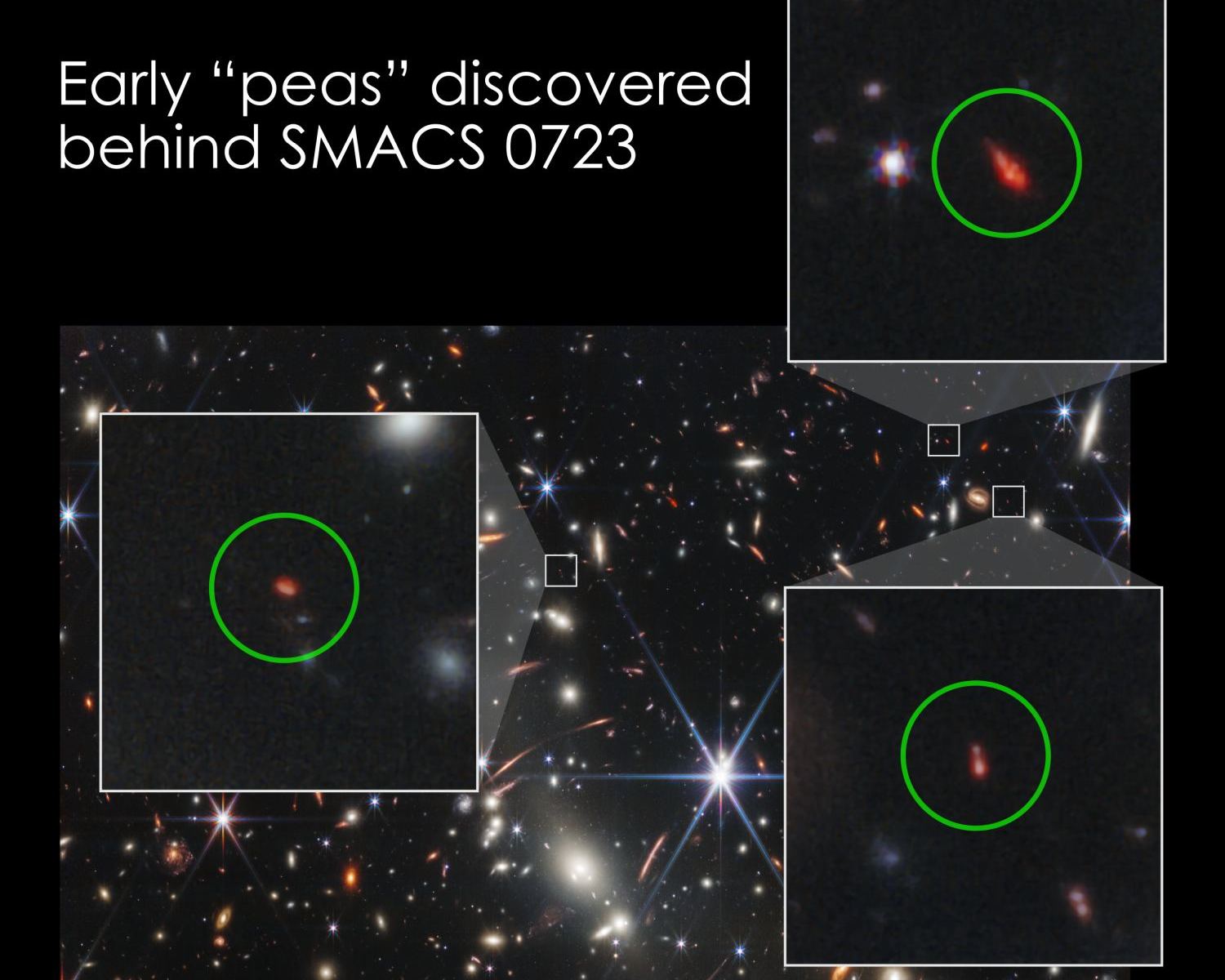When the James Webb Space Telescope lifted off from Earth on Christmas Day in 2021, it carried a lot of expectations with it. One of its scientific goals is to seek the light from the first galaxies in the Universe and to study how galaxies form and evolve.
A new paper shows that the JWST is doing just that and has found a link between the first galaxies and rare galaxies in our backyard that astronomers call “Green Pea” galaxies.
One of the big questions in cosmology is how galaxies first formed and then evolved into the vast spiral-armed structures we see today. The appearance of the first galaxies is tied to the Epoch of Reionization (EOR) and the end of the Universe’s Dark Ages. Before the first stars and galaxies formed in the Universe, there was nothing but an impenetrable haze of primordial gas. Once stars formed inside galaxies, their powerful ultraviolet light reionized the hydrogen, allowing light to travel through the Universe.
The evidence for the EOR is buried in the deep, distant past. The light from those early galaxies has been stretched to extreme redshifts by the expansion of the universe since then, and the JWST was meticulously designed to detect that infrared light. It has succeeded, and early in its scientific mission, the JWST has already detected the oldest galaxies ever found, dating to only 350 million years after the Big Bang.
A new paper published in The Astrophysical Journal Letters shows how some of these very early galaxies are remarkably similar to some oddball galaxies that are much younger and live in our cosmic backyard. The paper is “Finding Peas in the Early Universe with JWST.” The lead author is James Rhoads, an astrophysicist at NASA’s Goddard Space Flight Center.
“With detailed chemical fingerprints of these early galaxies, we see that they include what might be the most primitive galaxy identified so far,” Rhoads said in a press release. “At the same time, we can connect these galaxies from the dawn of the universe to similar ones nearby, which we can study in much greater detail.”

Green Peas are a type of galaxy first identified in the citizen science Galaxy Zoo Project. In that project, citizen scientists set about identifying galaxies in the large amounts of image data generated by surveys like the Sloan Digital Sky Survey. The Green Pea galaxies were noteworthy because they’re small, round dots that are difficult to resolve. They’re also green, partly because of how the images are filtered and partly because of their metallicity, or chemical makeup.
But Green Peas are also green because they host very active star formation. Unlike stars, which emit light across the electromagnetic spectrum, the light from green peas comes from clouds of glowing gas lit up by starlight. So instead of seeing the unfiltered starlight, we see only the light from the energized gas clouds.
“Peas may be small, but their star-formation activity is unusually intense for their size, so they produce bright ultraviolet light,” said Keunho Kim, a postdoctoral researcher at the University of Cincinnati and a member of the analysis team.

Green Peas are only about 5,000 light-years across. Compare that to most modern galaxies like the Milky Way, about 85,000 light-years across. Green Pea galaxies are clearly odd, and astronomers are very interested in them.
Astronomers are also interested in the earliest galaxies, and the James Webb has excelled in finding them. The authors of this study examined data from the JWST’s Early Release Observations (ERO.) That data included the sharpest and deepest infrared image of the Universe ever captured. The image was centred on a galaxy cluster called SMACS 0723, which acted as a gravitational lens and improved the already impressive reach of the JWST. The gravitational lens magnified the light from galaxies beyond the galaxy cluster.
Among those galaxies, astronomers identified three that shared the same properties as Green Peas. One of them had its light magnified ten times by the galaxy cluster, a remarkable set of natural circumstances that augmented the JWST’s formidable power.

Part of the JWST’s power is in its Near-Infrared Spectrograph (NIRSpec) instrument. NIRSpec can observe the spectra of hundreds of objects at a time. When Rhoads and his colleagues examined the spectra of all the galaxies in the image, they found the three resembling Green Peas. Green Peas are characterized by oxygen, hydrogen, and neon emissions, and the team found the same characteristics, or chemical fingerprints, in the three ancient, distant galaxies.

There’s something unusual going on when galaxies about 13 billion years old have the same chemical fingerprint, or metallicity, as much younger galaxies. That’s because metallicity increases with the age of the Universe. Metallicity, which in astronomy refers to chemical elements heavier than hydrogen and helium, increases as subsequent stars live and die. Stars create heavier elements through nucleosynthesis, and when the stars die, they spread those metals out into space to be taken up in the next generation of star formation.
“We’re seeing these objects as they existed up to 13.1 billion years ago when the universe was about 5% its current age,” said Goddard researcher Sangeeta Malhotra. “And we see that they are young galaxies in every sense – full of young stars and glowing gas that contains few chemical products recycled from earlier stars. Indeed, one of them contains just 2% the oxygen of a galaxy like our own and might be the most chemically primitive galaxy yet identified.”
Oxygen content plays an important role in the comparison. Two of the three galaxies contain only 20% as much oxygen as the Milky Way, and one contains only 2%. Their oxygen content is very similar to Green Peas. Why would modern Green Pea galaxies have the same metallicity as the Universe’s first galaxies?
Part of the answer lies in the Green Peas. In terms of metallicity—especially oxygen content—and star formation, they’re low-redshift analogs of the three high-redshift galaxies in the JWST image. Since they’re so much closer, they’re far easier to observe and study.
“Low-redshift analogs for Epoch-of-Reionization galaxies have been of tremendous value in recent years because they have allowed us to study in nearby objects properties that could not be directly studied in faint, redshifted galaxies at Cosmic Dawn,” the authors write in their paper. Their work demonstrates how the powerful JWST can tease out important details in the emissions from the faint, redshifted galaxies. Though these results are based on the JWST’s Early Release Operations, future observations will provide more detail on the ancient galaxies. “These will ultimately include metallicity, temperature, ionization parameter, density, and gas pressure,” they explain.
But some properties of these early galaxies will remain hidden due to the obfuscating effect of extreme redshifts. Some of those properties are more readily observable in the Green Peas. “For example, radio emission from atomic gas in single galaxies can be studied in Green Peas but is far beyond reach in the early universe,” they explain. Those radio emissions can tell astronomers more about the hydrogen and the star formation in the galaxies, among other things.
Finding links between Green Peas and ancient, highly-redshifted galaxies is a significant development in cosmology. It means that observations of Green Peas can help explain the early galaxies. “Thus, JWST now equips us to establish the validity of local analog populations with unprecedented detail and confidence, opening the way for further progress using both the most distant and the closest young galaxies,” the researchers explain.
More:
- Press Release: NASA’s Webb Telescope Reveals Links Between Galaxies Near and Far
- Published Research: Finding Peas in the Early Universe with JWST
- Universe Today: Webb Stares Deeply Into the Universe, Showing How Galaxies Assemble

